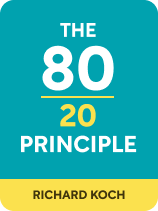

This article is an excerpt from the Shortform book guide to "The 80/20 Principle" by Richard Koch. Shortform has the world's best summaries and analyses of books you should be reading.
Like this article? Sign up for a free trial here .
How does the Pareto 80/20 rule apply in business? How can you identify the 20% of inputs and activities that make the most difference to your business’s bottom line?
In any company, you can predict that 80% of profits are generated by 20% of inputs in each domain, including customers, products, employees, and departments. According to Richard Koch, there are two ways you can identify the top-performing 20% of those inputs: conducting an 80/20 Analysis and applying 80/20 Reasoning.
Let’s briefly review each method.
Method #1: Conduct An 80/20 Analysis
One option is to perform an 80/20 Analysis, which involves gathering two different sets of data—one measuring a percentage of all inputs and the other measuring a percentage of all outputs flowing from each of those inputs. For example, conduct an analysis to determine what percentage of your total profits come from sales of each product. Then, do a similar analysis to determine what percentage of total sales are completed by each salesperson, and continue doing this for all the variables related to your company’s key inputs and outputs. This process will reveal the top-performing inputs within your company.
| Best Practices for Doing an 80/20 Audit and Getting the Most Benefit From Data As Koch says, conducting an 80/20 Audit can reveal valuable insights on the top-performing inputs in your company. Research shows that companies around the world could collectively gain between $9.5 and $15.4 trillion in value through effective use of data. However, studies also show that only 20% of insights from data will actually deliver business outcomes. Why? Because many companies don’t follow recommended best practices, which Koch doesn’t cover. Here are three best practices you should follow: First, secure total commitment from all decision-makers and stakeholders. If people make decisions based on intuition or incomplete knowledge, you will not be able to derive the most value from the data you collect. Therefore, all managers, executives, and team leaders need to be committed to gathering and analyzing data, and they must weave this approach into their day-to-day operations. Second, make data and insights accessible and easy to understand. If people throughout your company are informed about the meaning of data and how it’s being used in various departments, they’ll know how to align their actions in a way that benefits the company. Third, refine your data collection and analysis processes continuously. As your company changes—through mergers and acquisitions, as well as new products and markets—you’ll need to gather new kinds of data and adjust the way you assess that data. By incorporating these best practices, you’ll be able to make the most of the 80/20 Audit Koch describes. |
Method #2: Apply 80/20 Reasoning
Another option, says Koch, is to engage in 80/20 Reasoning (what he calls 80/20 Thinking), which involves reflecting on observations you’ve made in your company, then acting on your insights. For example, maybe you’ve noticed that only a select few salespeople repeatedly earn quarterly bonuses for their high volume of sales, or you’re constantly having to reallocate resources because your North American branch fails to reach revenue goals. These insights will help you separate top-performing aspects of your business from those that underperform.
In contrast to the 80/20 Audit, 80/20 Reasoning does not involve rigorous data collection and analysis. Rather, it relies on broad observations and intuition. Thus, it’s possible that you could make some inaccurate assessments. However, Koch says that 80/20 Reasoning is faster, easier to execute, and less likely to mislead you than non-reflective, emotion-based thinking.
Koch says that you can use either of these methods to identify your top 20%, but he advises performing an 80/20 Audit when your issue is extremely important and complex. Gathering and analyzing data will increase your chances of making decisions that reflect underlying realities within the company.
| Possible Corrosive Effects of the 80/20 Principle in Businesses Although Koch touts the benefits of applying the Pareto 80/20 rule, he doesn’t address potential negative consequences that could stem from its application, which others have highlighted. In a business setting, the 80/20 Principle could be used to justify giving the highest and most frequent bonuses to the top 20% of performers—and that could backfire. Employees will see each other as competitors for scarce rewards, making them less inclined to work together. Also, it could make the 80% of lower performers feel like they don’t matter, thereby demotivating them to contribute even at their current level, much less improve. Research by Gallup found that disengaged employees have 18% lower productivity, 37% higher absentee rates, and 15% lower profitability. So, focusing only on the top 20% could result in a self-fulfilling prophecy that actually creates an even wider gap, pushing 80/20 more towards 90/10 or 95/1. As a result, businesses can miss out on valuable talent and innovative ideas that could help drive the company forward. Indeed, research shows that companies that rely on input from just a small percentage of their employees innovate less and encounter more barriers around problem-solving and communicating with customers from specific markets. In contrast, companies that intentionally gather input from diverse people across their workforce innovate more and benefit from wide-ranging perspectives. For example, people who represent different races, genders, cultural backgrounds, and sexual orientations can share how likely they are to respond to a particular marketing message, which allows company leaders to see the probable impact of critical decisions from multiple angles. Thus, critics of 80/20 say the focus of business leaders should be finding ways to get people at all levels of a company to contribute ideas—and getting top performers to bring the other 80% up to their level, contrary to Koch’s advice. |

———End of Preview———
Like what you just read? Read the rest of the world's best book summary and analysis of Richard Koch's "The 80/20 Principle" at Shortform .
Here's what you'll find in our full The 80/20 Principle summary :
- How you can work less, earn more, and multiply your happiness
- What the 80/20 Principle is and why it matters
- The mindset shifts you must make to take advantage of the 80/20 Principle






